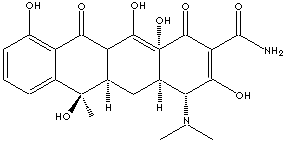PRODUCT IDENTIFICATION
6416-04-2 (trihydrate)
64-75-5 (hydrochloride)

H.S. CODE
TOXICITY
SMILES
C[C@]1(c2cccc(c2C(=O)C3=C([C@]4([C@@H](C[C@@H]31)[C@@H] (C(=C (C4=O)C(=O)N)O)N(C)C)O)O)O)O
CLASSIFICATION
Antibiotic, Antiamebic, Antibacterial, Antirickettsial
EXTRA NOTES
PHYSICAL AND CHEMICAL PROPERTIES
AUTOIGNITION
NFPA RATINGS
REFRACTIVE INDEX
Stable under ordinary conditions
EXTERNAL LINKS & GENERAL DESCRIPTION
USA.gov - Tetracycline
Wikipedia Linking - Tetracycline
Google Scholar Search - Tetracycline
U.S. National Library of Medicine - Tetracycline
PubChem Compound Summary - Tetracycline
Drug Bank - Tetracycline
KEGG (Kyoto Encyclopedia of Genes and Genomes) - Tetracycline
ChEBI (http://www.ebi.ac.uk/chebi/) - Tetracycline
NCBI (http://www.ncbi.nlm.nih.gov/) - Tetracycline
Human Metabolome Database - Tetracycline
Hazardous Substances Data Bank - Tetracycline
EPA - Substance Registry Services - Tetracycline
http://www.sigmaaldrich.com/
Tetracyclines possess a wide range of antimicrobial activity against gram-positive and gram-negative bacteria. The bacterial ribosome is the site of action of tetracyclines. Access to the ribosomes of gramnegative bacteria is obtained by passive diffusion through hydrophilic pores in the outer cell membrane and then by an energy-dependent active transport system that pumps all tetracyclines through the inner cytoplasmic membrane.
Local:
Tetracycline is a member of the tetracycline family useful because of broad antimicrobial action. It is chiefly used in treating infections caused by streptococci, staphylococci, Gram-negative bacilli, rickettsiae, and certain protozoans and viruses. Tetracycline can be produced biosynthetically by fermentation with a strain of Streptomyces aureofaciens (or certain other species) or chemically by hydrogenolysis of chlortetracycline. Tetracyclines inhibit bacterial protein synthesis by binding to the 30S ribosomal subunit. tetracyclines act as a inhibitor of a growth (bacteriostatic) rather than killer of the infectious agent (bacteriocidal) and is only effective against multiplying microorganisms.
Tetracycline antibiotics include;
- Chlortetracycline (CAS # : 57-62-5)
- Demeclocycline Hydrochloride (CAS # : 64-73-3)
- Demethylchlortetracycline (CAS # : 127-33-3)
- Dihydrostreptomycin Sesquisulfate (CAS # : 5490-27-7)
- Doxycycline (CAS # : 564-25-0)
- Duramycin (CAS # : 1391-36-2)
- Meclocycline Sulfosalicylate (CAS # : 73816-42-9)
- Methacycline Hydrochloride (CAS # : 3963-95-9)
- Minocycline (CAS # : 10118-90-8)
- Neomycin (CAS # : 1404-04-2)
- Oxytetracycline (CAS # : 6153-64-6)
- Streptomycin (CAS # : 57-92-1)
- Tetracycline (CAS # : 60-54-8)
- Vancomycin (CAS # : 123409-00-7)
APPEARANCE
ASSAY
88.0% min
HAZARD OVERVIEW
GHS (Globally Harmonised System) Classification: Acute toxicity (Oral). Hazard statements: Harmful if swallowed. Potential Health Effects: Eyes - May cause eye irritation. Skin - Harmful if absorbed through skin. May cause skin irritation. Ingestion - Harmful if swallowed. Inhalation - May be harmful if inhaled. May cause respiratory tract irritation.
GHS
Warning
PICTOGRAMS

HAZARD STATEMENTS
H302
P STATEMENTS
P264-P270-P301 + P312-P330-P501
![]()
RISK PHRASES
22
SAFETY PHRASES
22-36